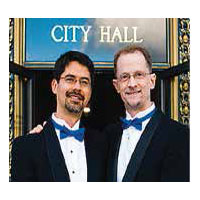 By Stuart Gaffney and John Lewis
By Stuart Gaffney and John Lewis
The U.S. Supreme Court’s two landmark marriage equality decisions contain powerfully eloquent declarations of the dignity and humanity of LGBTQ people. When the decisions were announced, the nation’s newspapers translated the “take home” message of the legal holdings in more down to earth ways. The New York Daily News front page headline screamed, “U.S. GAY! ‘Equal dignity in the eyes of the law.’” The Montgomery, Alabama, Advertiser proclaimed, “LOVE WINS.” The Lafeyette, Indiana, Journal & Courier declared, “GAY WIN-WIN,” and USA Today’s front page announced, “Rainbow Rulings,” with a huge close-up photograph of a happy gay couple kissing on the steps of the U.S. Supreme Court.
For years, we and many others in the marriage equality movement have hoped that our efforts would not only help secure equal marriage rights for LGBTQ couples, but also that our work would help our community achieve equality and dignity in all aspects of our lives. We intended for marriage equality to contribute to decades-long efforts to give LGBTQ youth hope to be able envision their lives in any way they chose and to experience happiness rather than shame in being LGBTQ. But the degree to which all the public education, the legal victories, the sights of LGBTQ people getting married coast to coast, and the bold headlines proclaiming, “U.S. GAY,” were resonating with young people was difficult to assess or quantify—until very recently.
On February 20, 2017, researchers from the Johns Hopkins and Harvard schools of public health announced stunning new findings: the number of adolescent suicide attempts in states that achieved marriage equality from 2004 to the beginning of 2015 dropped dramatically, while states that rejected equality saw no change during the same time period. When the researchers added up all the numbers, they found that over 134,000 fewer adolescents per year attempted suicide in states that adopted marriage equality with no reductions in states that maintained discriminatory laws. In equality states, adolescent suicide rates dropped 7 percent, with a 14 percent drop for lesbian, gay, and bisexual students. And the study found that reductions in suicide attempts were sustained over time, with lower rates remaining two years after legalization.
The study’s lead author, Julia Raifman, observed, “These are high school students so they aren’t getting married any time soon, for the most part;” however, “[t]here may be something about having equal rights—even if they have no immediate plans to take advantage of them—that makes students feel less stigmatized and more hopeful for the future.” Of course, many other concomitant efforts, such as anti-bullying measures and increasing numbers of LGBTQ people coming out in states that adopted marriage equality, could contribute to the improvements, and the study recognized that it could not identify the mechanism by which marriage equality lowered adolescent suicide rates. But interestingly, the study found that the reduction in suicide attempts did not occur until after marriage equality actually passed, and did not take place in the years leading up to the legal victory.
Despite this progress, teen suicide attempts, especially among LGBTQ youth, remain a huge problem. The study reported that in 2015, over 29 percent of LGBQ high school students reported having attempted suicide in the past year, compared to 6 percent of their heterosexual counterparts. In 2015, 34 percent of high school students who reported attempting suicide were LGBQ. Other data suggests that approximately 40 percent of transgender Americans have attempted suicide at some point in their lives. It appears that the researchers had access only to data that tracked sexual orientation, and consequently were unable to provide information about transgender adolescents.
The “Healthy People 2020” program administered by the federal Department of Health and Human Services (HHS) seeks to reduce adolescent suicide rates by ten percent by 2020. The study’s authors note that their “research suggests that the legalization of same-sex marriage has been very effective in making progress toward that goal.” We hope that the new HHS Secretary Tom Price, who has been a staunch opponent of marriage equality, and others in the new administration take note. As Raifman observed, “We can all agree that reducing adolescent suicide attempts is a good thing, regardless of our political views.”
The study provides compelling evidence that legal and public policy pertaining to LGBTQ rights can have profound effects on the mental health and well-being of LGBTQ youth. We look to the U.S. Supreme Court to recognize this fact when they consider the extent to which federal law protects transgender youth later this month.
The Supreme Court in its nationwide marriage equality decision stated: “Marriage responds to the universal fear that a lonely person might call out only to find no one there. It offers the hope of companionship and understanding and assurance that while both still live there will be someone to care for the other.”
Our hope is that the achievement of nationwide marriage equality results in reductions in adolescent suicide attempts nationwide and that fewer LGBTQ youth find themselves calling out in loneliness. We look to the Court, other judges, and lawmakers to recognize the far-reaching impacts of legal protections for LGBTQ people. And when LGBTQ youth call out in loneliness, it’s the responsibility of friends, family, teachers, counselors, and the larger community to be there to provide care and understanding. We must make real the proclamations of the newspaper headlines that “Love Wins” and legal equality is a “Gay Win-Win.”
The complete study, “Difference-in-Differences Analysis of the Association Between State Same-Sex Marriage Policies and Adolescent Suicide Attempts,” can be found at http://jamanetwork.com/journals/jamapediatrics/fullarticle/2604258
John Lewis and Stuart Gaffney, together for over three decades, were plaintiffs in the California case for equal marriage rights decided by the California Supreme Court in 2008. Their leadership in the nationwide grassroots organization Marriage Equality USA contributed in 2015 to making same-sex marriage legal nationwide.
Recent Comments